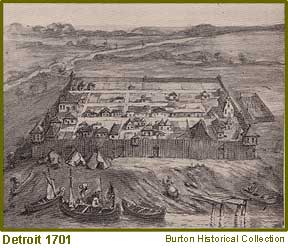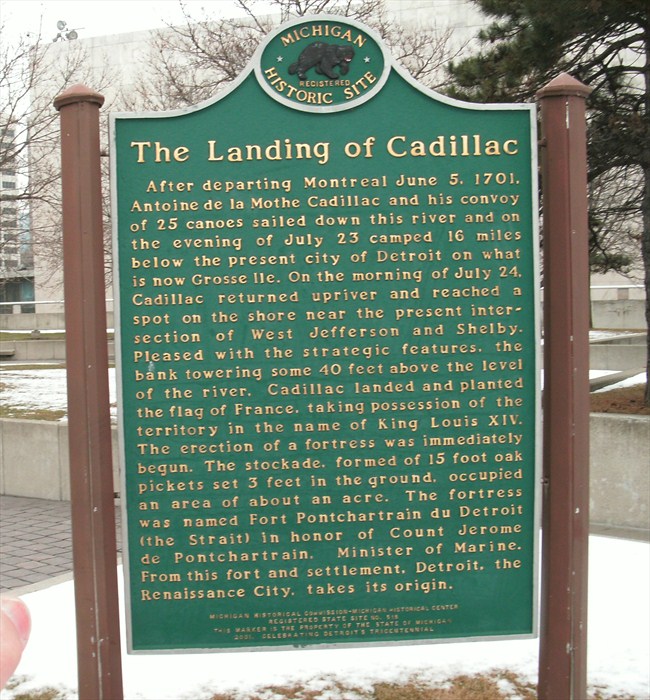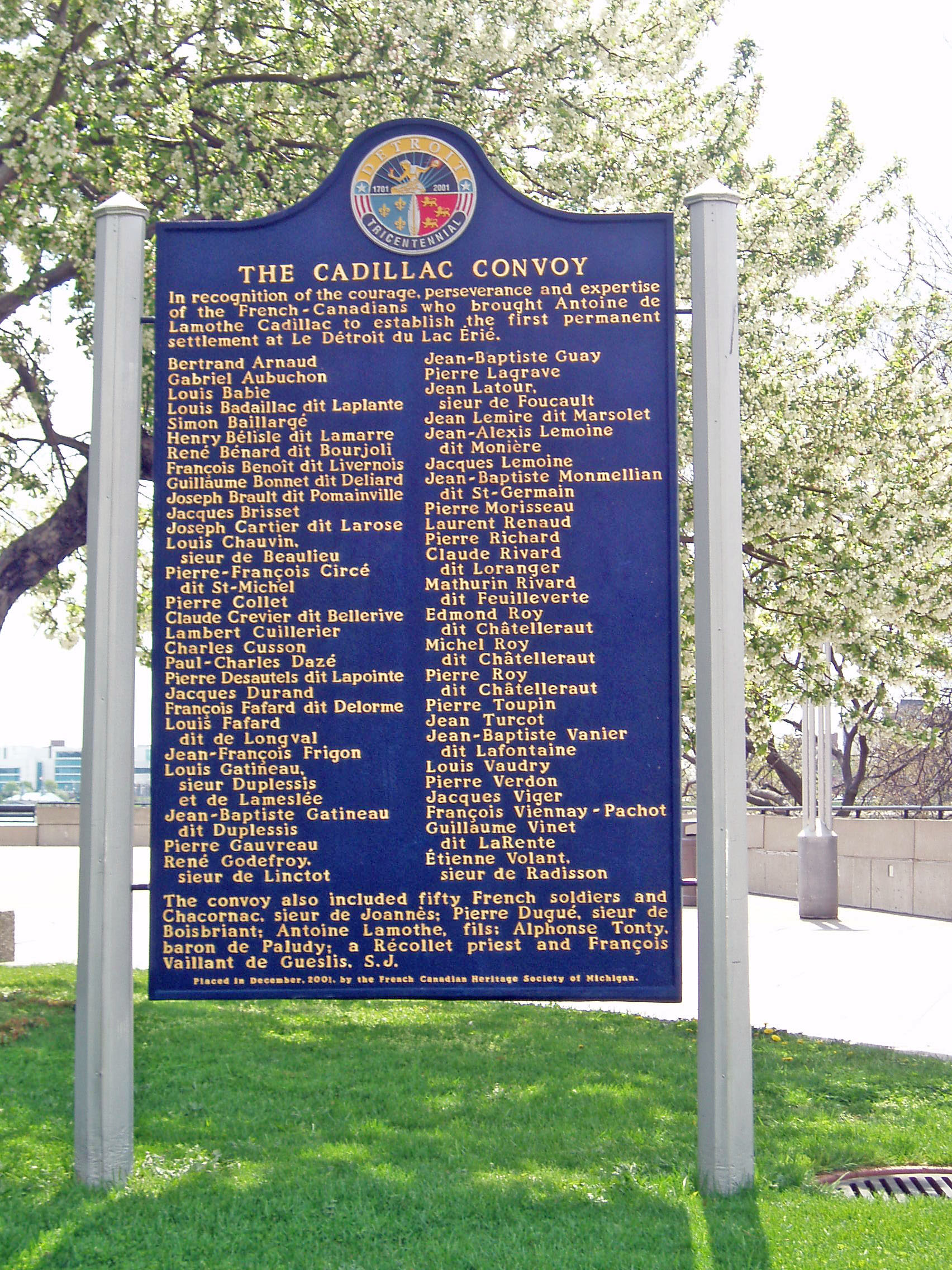How was a “Jesmer” ancestor involved in the founding of Detroit?
How was a “Jesmer” ancestor involved in the founding of Detroit?
Link to Jesmer family history page
Link to Nelson and Jenny Jesmer’s page
Link to Jesmer Mysteries Explained

The Cadillac Convoy Monument
The Cadillac Convoy, a monument established for the 300th anniversary of Cadillac arriving in Detroit. Included on the sign is Francois Fafard dit Delorme, an ancestor up the Jesmer line.
Here’s the line:
Nelson A. Jesmer >Joseph A Jesmer >Joseph Jasmin>Louis Joseph Jasmin>Marie Magdeleine DuCorp> Mary Marguerite Bisaillon>Marguerite Fafard>Francois Fafard>Francois Fafard dit DeLorme.
Some Info off of public records concerning the “Jesmer” ancestors in early Detroit.
I)-Richard le Michel Bizaillon (Bisaillon) d-1728 and wife (married June 30, 1710) Marguerite Fafard dit Delorme, town rent, lot was purchased from Solomon Joseph Du Vestin.
(I)-Francois Fafard De Lorme (Delorme) (1654-1734) interpreter, wife Marie Magdeleine Jobin born 1671 died January 29, 1711 Fort Detroit, New France (Michigan), 2nd wife 1713 Barbe Loisel, in town and farming 1 arpent, March 10, 1707, for 4 livres and 10 sols rent, and 10 livres for other rights.
(II)-Charles Fafard dit Delorme, arrived April 25, 1707, son (I)-Francois Fafard, dit Delorme, no rent
Francois Legautier, esquire, sieur de la Vallee Ranee, (Deranee), died November 12, 1710, arrived October 2, 1709, wife Barbe Loisel, departed for Detroit September 6, 1708, she married three times, 1st. Pierre Roussel, 2nd Legautier and 3rd in 1713 (I)-Francois Fafard dit Delorme, no rent
Francois Susart, called Delorme, no rent
http://www.telusplanet.net/public/dgarneau/metis4a.htm
Info about the monument
In recognition of the courage, perseverance and expertise of the French Canadians who brought Antoine de Lamothe Cadillac to establish the first permanent settlement at Le Detroit du Lac Erie. ….the convoy also included fifty French soldiers….
Inscription. The Landing of Cadillac (English side)
After departing Montreal June 5, 1701, Antoine de la Mothe Cadillac and his convoy of 25 canoes sailed down this river and on the evening of July 23 camped 16 miles below the present city of Detroit on what is now Grosse Ile. On the morning of July 24, Cadillac returned upriver and reached a spot on the shore near the present intersection of West Jefferson and Shelby. Pleased with the strategic features, the bank towering some 40 feet above the level of the river, Cadillac landed and planted the flag of France, taking possession of the territory in the name of King Louis XIV. The erection of a fortress was immediately begun. The stockade, formed of 15 foot oak pickets set 3 feet in the ground, occupied an area of about an acre. The fortress was named Fort Pontchartrain du Detroit (the Strait) in honor of Count Jerome de Pontchartrain, Minister of Marine. From this fort and settlement, Detroit, the RenaissanceCity, takes its origin.
http://www.hmdb.org/marker.asp?marker=33522
N 42° 19.628 W 083° 02.618
17T E 331617 N 4688120
Antoine de la Mothe Cadillac
Is outlined well on the SIRIS site, a portion is used below.
Description:
A portrait of Antoine de la Mothe Cadillac depicted as he first stepped foot on the soil that would become Detroit. He wears his French soldiers uniform and holds a flag featuring the symbol of France, the fleur-de-lis, in his right hand. The sculpture is flanked by a Detroit Tricentennial plaque titled “The Cadillac Convoy” listing the men who were with Cadillac when he landed, and another plaque titled “The Landing of Cadillac” designating the sculpture as a registered Michigan historic site.
Remarks:
The sculpture was a gift from the French-American Chamber of Commerce in honor of the Detroit 300 Tricentennial celebration. The sculpture was chosen by a committee which included representatives of the French-American Chamber of Commerce, the City of Detroit, the Detroit Historical Society, the Detroit Institute of Arts, and Detroit 300 Tricentennial Committee.
Inscription:
(On base plaque:) Antoine de la Mothe Cadillac 1658-1730 Founder of the City of Detroit Dedicated July 24, 2001 In commemoration of the tricentennial of his arrival. Sculptors William Kieffer and Ann Feeley A gift to the people of the French-American Chamber of Commerce Auto Chassis International-Burelle Dessault Systemes -Delmia -Faurecia Hutchinson Jean-Pierre Kemper -Bruno Marko -Sescoi Sofanou -Valeo Arcadis Giffels-; Barton Malo Detroit Recreation Department.
http://www.waymarking.com/waymarks/WM83B5_Antoine_de_la_Mothe_Cadillac_Detroit_Michigan
The city’s name originates from the DetroitRiver (French: le détroit du lac Érié, meaning the strait of Lake Erie), linkingLake Huron and Lake Erie; in the historical context, the strait included Lake St. Clair and the St. Clair River.[21][22]
There, in 1701, the French officer Antoine de La Mothe Cadillac, along with fifty-one additional French-Canadians, founded a settlement called Fort Ponchartrain du Détroit, naming it after the comte de Pontchartrain, Minister of Marine underLouis XIV. France offered free land in an effort to attract families to Detroit, which grew to 800 people in 1765, the largest city between Montreal and New Orleans.[23] By 1773, the population of Detroit was 1,400. By 1778, its population was up to 2,144 and the third largest city in the Province of Quebec.[24]
Ste. Anne de Détroit, founded in 1701, is the second oldest continuously operating Roman Catholic parish in the United States. The present church was completed in 1887.[25]
The region’s fur trade was an important economic activity. Detroit’s city flag reflects this French heritage. (See Flag of Detroit, Michigan).
http://en.wikipedia.org/wiki/Detroit
Fort Detroit began on the Detroit River built to try to keep the British from moving west of New England and to monopolize the fur trade in North America. Before he built FortDetroit, Cadillac was commandant of Fort de Buade, another French outpost in North America. Fort de Buade was abandoned in 1697 due to conflicts with religious leaders over the trading of alcohol to the Native Americans. Cadillac then persuaded his superiors to let him build a new settlement. He reached the DetroitRiver on July 23, 1701.
When he landed on the site he held a celebration to formally take control of the area. In honor of Louis Phélypeaux, Comte de Pontchartrain (or his son, Jérôme), Minister of Marine to Louis XIV he named the new settlement Fort Ponchartrain du Detroit. The storehouse and the stockade were started immediately, but the first building completed was Ste. Anne’s Church. The stockade came next and was made of logs rising about 12 feet into the sky with towers in each corner.
http://en.wikipedia.org/wiki/Fort_Detroit











Interact with us using Facebook